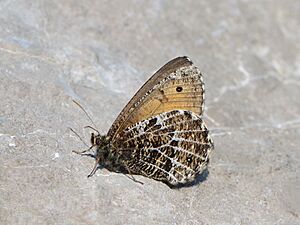Alpine grayling facts for kids
Quick facts for kids Alpine grayling |
|
|---|---|
 |
|
| Scientific classification |
The Alpine Grayling (scientific name: Oeneis glacialis) is a beautiful butterfly that belongs to the Nymphalidae family. You can find these butterflies high up in the Alps, living at altitudes from 1400 to 2900 meters above sea level. Their wingspan is about 50 to 56 millimeters, which is roughly the length of a small paperclip. These butterflies usually fly around from June to August, but this can change depending on where they live in the mountains. Young Alpine Graylings, called larvae, enjoy eating different types of Festuca grass.
Contents
Spotting the Alpine Grayling
The Alpine Grayling has different colors depending on if it's a male or female.
- Male butterflies are usually a light gray on their upper side.
- Female butterflies are a light brown on their upper side.
Both have a cool pattern on the underside of their back wings. It looks like dark gray marble with white lines, like tiny veins.
How to Tell Them Apart
If you are in the Alps, you might confuse the Alpine Grayling with two other butterflies: Lasiommata petropolitana or Lasiommata maera. But there's an easy way to tell them apart! The other two butterflies have big, noticeable eye-spots on their wings. The Alpine Grayling does not have these eye-spots.
Where Do Alpine Graylings Live?
The Alpine Grayling is a special butterfly that lives only in the Alps. You can find them all across the Alpine mountain range. They are especially common in the Central Alps.
Finding Them in Germany
In the German Alps, many Alpine Graylings are found in the Allgäu high Alps. Some have also been seen in the Vorderen Bregenz Forest and the Vilser Mountains. They are quite common in the Ammergau Alps. You can also find them in the Wetterstein and Karwendel Mountains. A few have been reported from the eastern Kochel Mountains, the Mangfall Mountains, and the Chiemgau Alps.
It's interesting that they are not found east of the Tiroler Ache river, all the way to the Berchtesgaden Alps. This seems to be a natural gap in their home range. In Austria, they mostly stay in the central Alps, only reaching the northern edge of the Alps west of the Inn river.
What Kind of Places Do They Like?
Alpine Graylings live at different heights, from 900 to 2300 meters. Most often, you'll find them between 1700 and 2000 meters high. Their German name, "Gletscherfalter" (glacier butterfly), might make you think they live near glaciers. But this name just refers to how high up they live.
They actually prefer places with short grass. They like areas where there's a mix of grassy patches, rocks, and loose stones. They also like dry, sunny spots. These are the most important things for their home.
Life of an Alpine Grayling
Adult Alpine Graylings are fast and agile fliers. They often land on the ground, rocks, wood, or dry grass. Their wing colors help them blend in very well with their surroundings.
Daily Habits
Male Alpine Graylings often protect their territory. They might also hide and wait for females to fly by. Sometimes, they even approach other insects by mistake! These butterflies don't visit flowers very often in Bavaria. However, they have been seen getting nectar from plants like Acinos alpinus, Rhododendron hirsutum, and Thymus species.
Life Cycle
Female butterflies lay their eggs one by one, usually close to the ground on dry grass leaves. The young caterpillars (larvae) eat Festuca ovina and other Festuca grass types.
The Alpine Grayling has a two-year life cycle. This means it takes two years for an egg to become an adult butterfly. The young caterpillar spends its first winter sleeping. Then, the older caterpillar spends its second winter sleeping before turning into a butterfly.
When Do They Fly?
These butterflies usually fly from early June to early August. The busiest time for them is often between late June and mid-July. In lower areas, or during very dry and warm springs, you might see them as early as mid-May. Depending on the weather, adult butterflies can live for quite a long time.
Interestingly, in Bavaria, more Alpine Graylings are seen flying in odd-numbered years (like 2001, 2003, 2005). But they are still present in even-numbered years, just in smaller numbers.
What Does "Glacialis" Mean?
The scientific name for the Alpine Grayling is Oeneis glacialis. The word "glacialis" comes from the Latin word for "icy" or "of glaciers." This refers to the high, cold places where these butterflies live.
The older name for this butterfly was Papilio aello. "Aello" is a Greek word for "one of the harpies," which were mythical creatures sent by gods to punish people.


